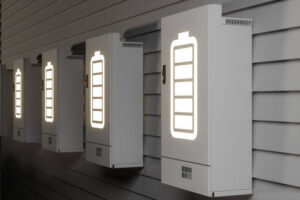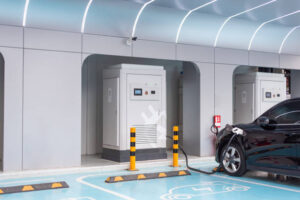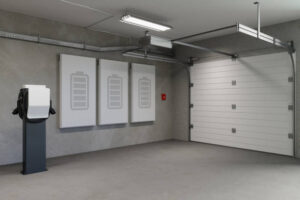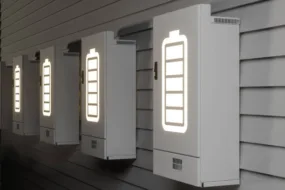Tesla Powerwall 3 and 2:

In the evolving landscape of home energy solutions, the Tesla Powerwall is a revolutionary product that promises to transform how we store and use electricity. With the release of the Tesla Powerwall 3, homeowners are faced with a decision: should they upgrade from the Powerwall 2, or is the older model still a viable choice? This article delves into the key differences, benefits, and applications of the Tesla Powerwall 3 versus the Powerwall 2, helping you decide which best boosts your home.
Understanding the Basics of the Tesla Powerwall 3 and 2 Comparison
The biggest difference between Powerwalls 2 and 3 lies in their energy storage capacity. The Powerwall 2 offers a usable capacity of 13.5 kWh (kilowatt-hours), which translates to roughly powering your essential appliances during an outage.
The Powerwall 3 takes things a step further, boasting a whopping 14.1 kWh of usable storage. This seemingly small jump might seem insignificant, but it can make a big difference, especially for larger homes or those with high evening energy needs. Think of it like having an extra gallon of gas in your backup generator—a small increase but potentially a lifesaver during extended outages.
Read more: How Long Do Tesla Powerwalls Last?
What are the Tesla Powerwalls 3 and 2 all about?
The Tesla Powerwall 3 and 2 are rechargeable lithium-ion batteries designed to store energy for residential use. It can store energy from the grid or solar panels, providing backup power during outages and optimising energy usage by storing excess solar power for use during peak demand times.
Since its inception, the Tesla Powerwall has seen significant upgrades. The Powerwall 2 brought enhancements in capacity and functionality compared to its predecessor, the original Powerwall. The latest iteration, Powerwall 3, builds upon these advancements with further improvements in efficiency, capacity, and ease of installation.
Exploring the Key Differences Between Powerwall 2 and Powerwall 3

1. Energy Capacity
One of the most critical aspects of any battery storage system is its energy capacity.
i. Powerwall 2 offers 13.5 kWh of usable capacity, which is suitable for most homes, providing enough power for essential devices and appliances during an outage.
ii. Powerwall 3: Tesla has increased the capacity to 15 kWh, giving homeowners more storage and, thus, more extended backup power during outages. This increased capacity also allows for more flexibility in energy usage, especially in larger homes or those with higher energy demands.
2. Power Output
The power output determines how much energy the battery can deliver at any given time.
i. Powerwall 2: It can deliver a maximum continuous power of 5 kW with a peak power output of 7 kW for short periods.
ii. Powerwall 3 boosts these figures to 5.5 kW of continuous power and 8 kW of peak power, allowing for more demanding electrical loads and greater flexibility in energy usage.
3. Efficiency
Efficiency is a critical factor in determining how much of the stored energy can be effectively used.
i. Powerwall 2 has a round-trip efficiency of about 90%.
ii. Powerwall 3 improves this slightly to 92%, meaning that less energy is lost in the process of storing and retrieving electricity.
4. Installation and size
i. Powerwall 2: It measures 1150 mm x 755 mm x 155 mm and weighs 114 kg. Installation requires a fair amount of space and a professional setup.
ii. Powerwall 3 is designed to be more compact and easier to install, although exact dimensions and weight haven’t been specified. The improved design aims to simplify the installation process and reduce the required space.
Read More: How to Build an Advanced Solar Energy Tracker
Exploring the Benefits of the Tesla Powerwall 3 Over Powerwall 2
1. Greater Storage Capacity
The increased capacity of the Powerwall 3 makes it ideal for homes with higher energy consumption. Whether you have a large family, run multiple high-demand appliances, or want more security during outages, the additional capacity provides significant benefits.
2. Improved power output
With a higher power output, the Powerwall 3 can support more demanding electrical loads. This means you can run more appliances simultaneously or operate high-power devices without compromising their overall performance.
3. Enhanced efficiency
Every bit of energy counts, especially when you’re relying on stored power. The slight bump in efficiency with Powerwall 3 means more of your solar-generated or grid-purchased energy is available for use, maximising the return on your investment.
4. Simplified installation
Easier and quicker installation means less hassle and potentially lower installation costs. A more compact design also means the Powerwall 3 can be installed in more places around your home, offering greater flexibility.
Applications of Tesla Powerwalls in Home Energy Management

1. Solar Energy Storage
Both Powerwalls 2 and 3 are excellent for storing solar energy. However, the increased capacity of Powerwall 3 makes it particularly effective for homes with large solar panel installations, enabling you to store more of the energy you generate.
2. Backup power
In areas prone to power outages, having a reliable backup power source is crucial. The Powerwall 3’s higher capacity and output provide more extended and robust backup power, ensuring your home remains powered during emergencies.
3. Time-of-Use Optimisation
With the ability to store energy when it’s cheapest and use it when rates are highest, both Powerwall versions can save you money on your electricity bills. The improved efficiency and capacity of Powerwall 3 enhance this capability, making it a more cost-effective solution.
4. Increased Grid Resilience
As more households use home battery systems, the strain on the power grid during peak hours decreases. This translates to a more stable and reliable power supply for everyone.
5. Self-Consumption Boost
Solar panels generate the most power during the day, but homes typically consume the most energy in the evenings. The Powerwall stores excess solar energy during the day and releases it in the evenings, maximising your solar power usage and reducing reliance on the grid.
Making Your Decision: Important Considerations
i. Home Energy Usage: To determine the ideal storage capacity, analyse your typical daily and seasonal energy consumption.
ii. Solar Panel System: Ensure your solar panel system can generate enough electricity to charge the powerwall.
iii. Local Regulations: In your area, check for any permits or regulations related to home battery installations.
iv. Installation Costs: Factor in installation costs along with the battery price to get a complete picture of the investment.
Read More: Exploring the Risks Linked with Natural Gas Investment
Challenges and Considerations

1. Initial Cost
The initial investment is the primary challenge with both versions. Tesla Powerwalls are not cheap, and while they offer long-term savings, the upfront cost can be significant. Powerwall 3, with its enhanced features, is expected to come at a higher price point than Powerwall 2.
2. Space requirements
Although Powerwall 3 aims to be more compact, it still requires space for installation. Homeowners need to consider where they will install the unit and ensure there’s adequate room.
3. Availability
With Tesla products, availability can sometimes be an issue. High demand and production delays can lead to long wait times for installation.
4. Scalability:
A single powerwall might not be enough for larger homes with high energy consumption. While you can install multiple Tesla Powerwalls, this further increases the upfront cost.
5. Limited Backup During Extended Outages:
The Tesla Powerwall’s capacity is finite. During prolonged outages, it might not be able to power your entire home for days on end.
Conclusion
In the comparison of the Tesla Powerwall 3 vs. 2, it’s clear that the Powerwall 3 offers significant improvements in capacity, power output, and efficiency. For homeowners with higher energy needs or those looking for the latest and greatest in-home energy storage, the Powerwall 3 is a compelling choice. However, for those who already have a Powerwall 2 or have moderate energy needs, the older model remains a highly effective solution.
Ultimately, the decision comes down to your specific energy requirements, budget, and plans for home energy management. Both Powerwall models deliver on Tesla’s promise of innovative, reliable, and efficient energy storage, helping you make the most of your solar investment and ensuring your home remains powered through any situation.








